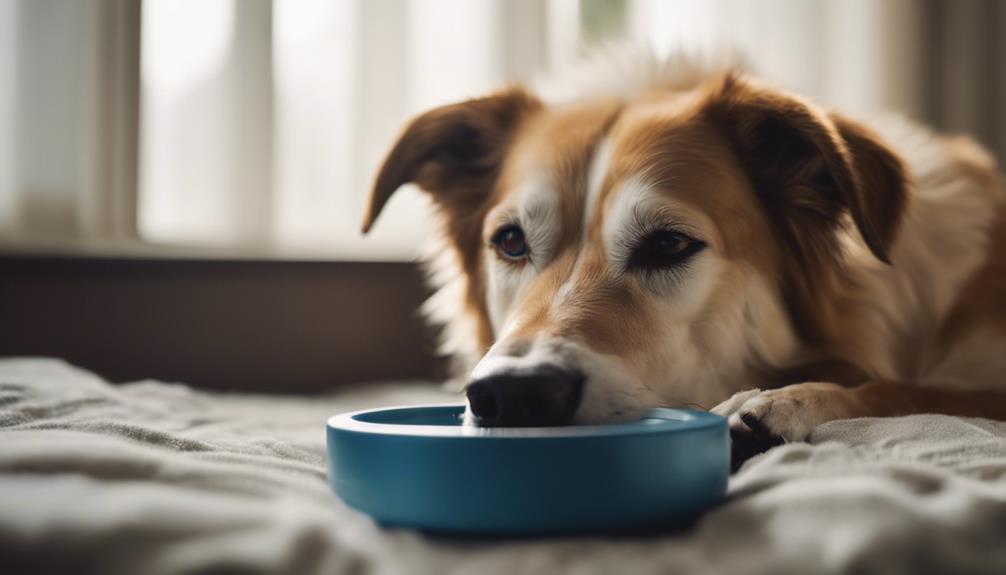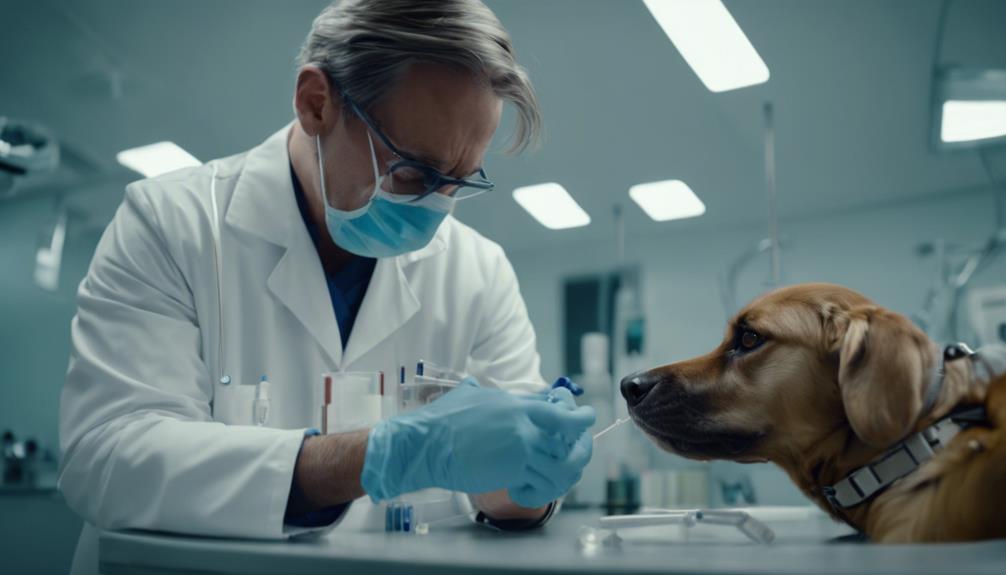Dehydration in dogs can stem from various triggers, ranging from common factors like excessive heat exposure to underlying health issues such as kidney dysfunction. It's imperative for dog owners to be vigilant in recognizing the subtle signs of dehydration, as prompt intervention can be a life-saving measure for our four-legged companions.
Understanding the causes, symptoms, and effective rehydration methods for dehydrated dogs is essential in safeguarding their well-being. By exploring the nuances of this topic, you can equip yourself with the knowledge needed to ensure your dog's hydration levels are always optimal.
Key Takeaways
- Recognize dehydration symptoms promptly to initiate rehydration.
- Monitor hydration through physical signs and urine color.
- Consult a vet for tailored rehydration methods and severity assessment.
- Use safe at-home techniques and provide clean water for hydration support.
Common Causes of Dog Dehydration
Dehydration in dogs can stem from various factors, with common causes including vomiting, diarrhea, excessive panting due to heat or exercise, loss of appetite, and underlying kidney disease. When dogs experience these issues, their fluid intake may not match their fluid loss, leading to dehydration.
Vomiting and diarrhea can rapidly deplete the body of fluids, while excessive panting can cause significant water loss, especially in hot climates or during intense physical activity. Dogs with kidney disease may have impaired kidney function, affecting their ability to regulate water balance.
It is crucial for dog owners to be aware of these common causes and take proactive measures to prevent dehydration in their furry companions.
Recognizing Dehydration in Dogs
Early detection of inadequate hydration in canines is paramount for ensuring their well-being and preventing potential health complications. Signs of dehydration in dogs include vomiting, diarrhea, excessive panting, and loss of appetite. Dry gums, lethargy, and sunken eyes are also indicators of dehydration.
Checking skin turgor by gently lifting the skin on the back of the neck is a useful way to assess hydration levels – skin that does not bounce back quickly can suggest dehydration. If you notice these symptoms, it is crucial to take prompt action to rehydrate your dog.
Providing access to fresh water, contacting a veterinarian for guidance, and monitoring your dog's hydration status are essential steps in managing dehydration in dogs.
Importance of Timely Vet Consultation

It is imperative for dog owners to promptly seek veterinary consultation when observing signs of dehydration or any concerning symptoms in their pets. Timely vet consultation is crucial in determining the underlying cause of dehydration and ensuring appropriate treatment is administered promptly.
Veterinarians have the expertise to assess the severity of dehydration, provide necessary interventions such as intravenous fluids, and monitor the dog's response to treatment. Delaying veterinary consultation can lead to complications and worsen the dog's condition.
Additionally, some symptoms of dehydration may overlap with other serious health issues, highlighting the importance of professional evaluation. Therefore, owners should not hesitate to contact their veterinarian at the first sign of dehydration in their dogs to ensure the best possible outcome for their pet's health.
Effective Veterinary Rehydration Methods
Veterinary professionals employ specialized rehydration techniques to address dehydration in dogs with precision and efficacy. One of the most common methods is intravenous (IV) fluid therapy, where fluids are administered directly into the dog's bloodstream to quickly restore hydration levels. This method is particularly useful in cases of severe dehydration or when the dog is unable to drink water orally.
Veterinarians may also use subcutaneous fluid therapy, where fluids are injected under the skin, allowing for gradual absorption. This method is often used for less severe cases of dehydration. Additionally, veterinary professionals may recommend specific electrolyte solutions tailored to the dog's needs to replenish essential nutrients lost during dehydration.
Such precise interventions ensure effective rehydration and support the dog's overall health and well-being.
Safe At-Home Rehydration Techniques

To effectively rehydrate a dehydrated dog at home, it is essential to employ safe and vet-approved techniques that prioritize the well-being of your furry companion. One safe at-home rehydration technique is to offer small amounts of water frequently to prevent overwhelming the dog's system.
Additionally, adding low-sodium chicken broth to the water can make it more appealing and encourage your dog to drink. Ice cubes can also be a refreshing way to provide hydration, especially on hot days.
It is important to avoid using human hydration solutions with high sugar content, as this can be harmful to dogs. Always consult with a veterinarian for guidance on the best rehydration techniques for your individual dog's needs.
Hydration Tips for Dog Owners
For responsible dog owners, ensuring proper hydration for their canine companions is essential to maintaining their overall health and well-being. Here are some hydration tips to help dog owners keep their pets properly hydrated:
Always provide access to fresh, clean water throughout the day, especially during hot weather or after physical activity. Consider adding chicken broth to your dog's water to entice them to drink more. Monitor the water bowl regularly, especially in cold weather to prevent freezing.
When taking your dog for walks, bring an adequate supply of water for both you and your furry friend. Never leave your dog in a hot car, as this can quickly lead to dehydration and heatstroke.
Hydration Treatments for Dehydrated Dogs

Proper hydration treatments play a crucial role in addressing dehydration in dogs, ensuring their health and well-being are safeguarded. When a dog is dehydrated, it is vital to take immediate action to rehydrate them. Here are some hydration treatments that can help:
| Treatment | Description |
|---|---|
| Veterinary Care | Contact a veterinarian for professional assessment and possible IV fluid administration. |
| Oral Rehydration Solutions | Administer electrolyte solutions specifically formulated for dogs to aid in hydration. |
| Subcutaneous Fluids | In some cases, subcutaneous fluids may be recommended by a veterinarian for hydration. |
| Water and Ice Chips | Encourage your dog to drink water or offer ice chips to help increase fluid intake. |
| Monitoring and Rest | Monitor your dog closely, provide a quiet and cool environment, and ensure access to water. |
Preventive Measures for Dog Dehydration
Implementing vigilance in dog care routines can significantly reduce the risk of dehydration in canine companions. Ensuring access to fresh, clean water at all times is crucial. Regularly check and refill water bowls, especially during hot weather when dogs are more prone to dehydration.
In cold weather, monitor the water bowl to prevent freezing. Limiting outdoor activity during peak heat hours can also help prevent excessive fluid loss through panting. When taking your dog for walks, always bring enough water for both of you to stay hydrated.
Remember never to leave your dog in a hot car, as this can lead to rapid dehydration and heatstroke. By following these preventive measures, you can help keep your furry friend well-hydrated and healthy.
Monitoring Canine Hydration Levels
Maintaining optimal levels of hydration in dogs is essential for their overall well-being, and a key aspect of this is monitoring their hydration levels regularly.
One effective way to monitor a dog's hydration status is by observing their skin turgor. To do this, gently lift the skin on the back of the dog's neck or between the shoulder blades and release it. In well-hydrated dogs, the skin should quickly return to its original position. If the skin remains tented or takes longer to return to normal, it may indicate dehydration.
Additionally, monitoring water intake and the frequency of urination can provide valuable insights into a dog's hydration levels. Regularly checking these indicators can help ensure that your dog remains adequately hydrated.
Ensuring Adequate Hydration for Dogs
Ensuring consistent access to clean and fresh water is fundamental to maintaining optimal hydration levels in dogs. Water is essential for various bodily functions, including temperature regulation, digestion, and nutrient transport.
To promote adequate hydration, pet owners should provide clean water in a clean bowl at all times. Regularly check the water bowl to ensure it is full and free of debris. In hot weather, consider using a shaded water bowl to keep the water cool. Additionally, adding ice cubes or flavoring the water with low-sodium chicken broth can entice dogs to drink more.
Conclusion
In conclusion, recognizing the signs of dehydration in dogs and taking prompt action is crucial in preventing severe health consequences. Veterinary care, including IV fluids, is essential for effectively rehydrating dehydrated dogs.
While home remedies can aid in rehydration, it is important to seek professional guidance to ensure safety.
By implementing preventive measures such as providing constant access to fresh water and monitoring outdoor activities, pet owners can significantly reduce the risk of dehydration in their canine companions.




